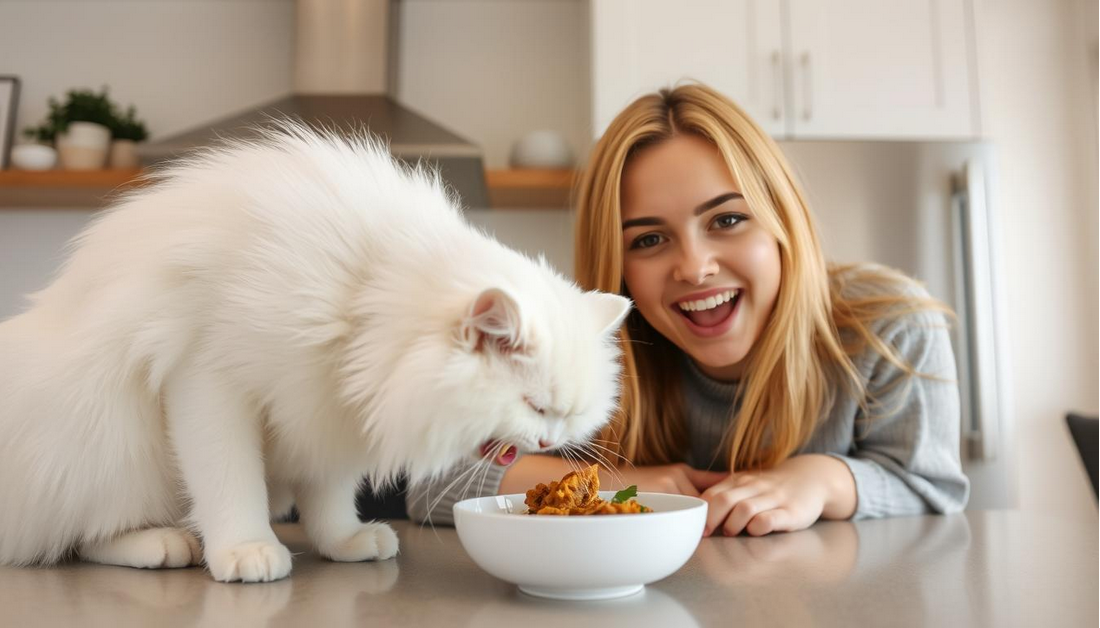India customers to view on amazon.in
Is Your Pet Getting Enough Protein?
Every pet parent wants their furry friend to thrive. But have you ever wondered, “Is your pet getting enough protein?” Protein is key for pet health, helping with energy, muscle growth, and immune strength. With many pet foods out there, it’s hard to know if your cat or dog’s diet is right.
- Understanding Pet Protein Needs
- Signs of Protein Deficiency in Pets
- Common Myths about Protein for Pets
- How Much Protein Do Pets Need?
- Choosing the Right Protein for Dogs and Cats
- Factors to Consider in Pet Food Protein Content
- Popular Protein Sources for Pets and What’s Best for Cats and Dogs
- Benefits of a High Protein Pet Diet
- Natural Sources of Protein for Pets
- Adjusting Your Pet’s Diet for Optimal Protein Intake
- Pet Food Protein Content Explained
- Is Your Pet Getting Enough Protein?
- Conclusion
- FAQ
- Is my pet getting enough protein?
- How much protein do pets need?
- What are the signs of protein deficiency in pets?
- Are high protein diets good for dogs?
- What is the best protein for cats?
- Can I add protein to my pet’s diet?
- How do I know if my dog needs more protein?
- Are plant proteins sufficient for my pet?
- Is too much protein bad for pets?
- How can I improve my pet’s diet?
This guide helps you make sure your pet gets the right amount of protein. It’s based on their lifestyle and age. You’ll learn about high protein diets and how to check if your pet’s meals are missing something.

Key Takeaways
- Protein fuels energy and supports pets’ overall health.
- Not all pet foods provide optimal protein levels for every life stage.
- High protein pet diets may benefit active or aging animals.
- Signs of deficiency include weakened fur or low energy.
- Consulting a vet helps tailor protein needs to your pet’s lifestyle.
Understanding Pet Protein Needs
Proteins are key for pets. They build muscles, boost immune systems, and give energy for daily tasks. But, not all proteins are the same. Knowing the differences helps ensure your pet gets the right nutrients.
What Is Protein and Why Pets Need It
Protein is the main energy source for pets. It’s vital for growth and repair. Animal proteins like chicken or fish give pets amino acids they can’t make themselves. Cats, being obligate carnivores, need this especially.
Without enough animal protein, pets can face health problems over time.

Animal vs. Plant Protein Sources
Animal proteins, like chicken or eggs, have all the amino acids pets need. Plant-based options, such as peas or soy, often miss some amino acids. Here’s the main difference:
- Animal Sources: Rich in taurine and arginine, key for cats and dogs. Found in high-quality pet food.
- Plant Sources: Can help but shouldn’t be the main protein. Look for brands that use more animal-based ingredients.
Pet food labels show protein content percentages. Always check the ingredients to make sure your pet gets enough quality protein.
Signs of Protein Deficiency in Pets
Do you notice changes in your pet’s behavior or looks? These could mean they’re not getting enough protein requirements for pets. Spotting these signs early can stop serious health problems. Let’s look at the main signs to watch for.

Behavioral and Physical Indicators
- Physical Clues: A dull, brittle coat or shedding a lot might mean they’re not getting enough protein. Muscle loss around the hips or ribs is another warning sign.
- Behavioral Changes: Feeling tired, not wanting to play, or getting easily upset could be due to low energy from bad protein rich pet food choices.
Recognizing Signs Your Pet Needs More Protein
Look out for these specific problems:
- Slow healing of small cuts or hotspots, as protein helps fix tissues.
- Shedding a lot or skin looking dry, even with regular grooming.
If you see these signs, it’s time to check your pet’s diet. Talk to a vet before changing to higher protein foods. Making sure your pet gets the right pet protein requirements keeps them full of energy and healthy. Even small changes in their food can make a big difference.
Common Myths about Protein for Pets
Many pet owners believe myths about protein that could affect their pets’ health. Let’s set the record straight on these common misconceptions.

- Myth 1: More protein is always better. Too much protein can harm pets, especially those with health problems. It’s important to find the right balance. Knowing how much protein do pets need depends on their age and how active they are.
- Myth 2: All pets have the same protein needs. Puppies, senior pets, and active breeds need special diets. Protein for dogs and protein for cats are different because of their unique needs.
- Myth 3: Plant protein equals animal protein. Cats need animal-based protein because they are obligate carnivores. Dogs can do well with a mix, but the quality is more important than the amount.
“A balanced diet starts with understanding your pet’s unique needs, not just chasing high protein numbers.” — Dr. Emily Carter, DVM
Myths often ignore the unique needs of each pet. Always check labels and talk to your vet. Making smart choices is key to your pet’s health, not following myths!
How Much Protein Do Pets Need?
Every pet is different, just like their personalities. A custom pet nutrition plan is key. It makes sure they get the right protein for their age and how active they are. Follow this pet diet guide to make sure their meals are just right.

Guidelines for Different Ages and Activity Levels
- Puppies/Kittens: Growing pets need 22–29% protein in their diet. High protein pet food supports rapid development.
- Adults: Active breeds like Border Collies require 18–22% protein. Sedentary pets may need slightly less.
- Seniors: Older pets often need 18–22% protein but consult a vet to adjust for health changes.
Calculating Ideal Protein Levels
Use this simple formula: Body weight (lbs) × 0.8 = daily protein grams. For example, a 50-lb dog needs about 40 grams of protein daily. Always check with your vet to avoid overfeeding.
Switching to quality high protein pet food and regular vet visits keeps your pet’s diet on track. Small changes can make a big difference in their energy and well-being.
Choosing the Right Protein for Dogs and Cats
Finding the best protein for pets means knowing their special needs. Dogs and cats do well on diets full of quality protein. But how do you pick the right one? Look for pet food with real meat as the first ingredient. Here’s how to choose the best for your furry friend.
Factors to Consider in Pet Food Protein Content
- Age and activity: Puppies, kittens, and active pets need more protein than older pets.
- Ingredient quality: Choose proteins like chicken, salmon, or lamb over fillers like corn or soy.
- Allergies: For pets with sensitivities, try novel proteins like duck or venison.

Popular Protein Sources for Pets and What’s Best for Cats and Dogs
Cats need animal-based proteins like turkey or fish because they’re obligate carnivores. Dogs can do well with both animal and plant proteins, but meat should come first. Here are some popular choices:
- Chicken: A common, easy-to-digest protein found in brands like Blue Buffalo.
- Fish: Rich in omega-3s, found in Orijen’s fish-based formulas.
- Lamb: Gentle on sensitive stomachs, featured in Wellness Core recipes.
Still unsure? Look for “pet food with protein” on labels to find quality options. If your pet seems tired or has a poor coat, they might not be getting enough protein. Ask your vet for advice.
Benefits of a High Protein Pet Diet
A diet rich in protein is key for your pet’s health. It helps build strong muscles, gives energy, and boosts their immune system. Meals with real meat, fish, or plant-based proteins like peas or lentils are best.
- Muscle maintenance: Protein repairs tissues and builds lean muscle, especially in active dogs or aging cats.
- Shiny coat, healthy skin: Essential amino acids promote a glossy fur coat and reduce shedding.
- Improved digestion: Premium protein sources like chicken or salmon are easier to digest than fillers like corn or soy.
“Adequate protein intake prevents weakness and lethargy, common signs your pet needs more protein,” says Dr. Emily Carter, a veterinary nutritionist. “Diets lacking protein can lead to protein deficiency in pets, affecting their ability to heal after injuries.”

Pets with allergies or sensitivities might do well on novel proteins like venison or duck. Choose foods where real meat is the first ingredient. If your pet has dry skin or seems less active, they might need more protein. Always talk to your vet before changing your pet’s diet to make sure it’s balanced.
Natural Sources of Protein for Pets
Feeding pets fresh, natural ingredients boosts their protein intake. It avoids artificial additives. Whole foods and homemade options tailor diets to your pet’s needs.
Whole Food Options for Animal Protein Needs
Dogs and cats need diverse protein sources. For protein levels in dog food to meet their needs, consider:
- Chicken and turkey: Lean meats provide essential amino acids for muscle maintenance.
- Fish like salmon: Rich in omega-3s and suitable for cats (what protein is best for cats).
- Beef and lamb: Great for dogs needing hearty protein sources.
- Eggs: A complete protein with biotin and vitamins.

Homemade Protein-Rich Pet Food Ideas
Creating meals at home lets you control protein levels in dog food. You can tailor dishes to your pet’s preferences:
- Chicken and sweet potato stew: Simmer boneless chicken with cooked veggies for a balanced meal.
- Cat-friendly tuna bites: Mix canned tuna with pumpkin for cats, ensuring mercury-free options.
- Beef and broccoli bites: Steam veggies and dice cooked beef for a crunchy, protein-packed snack.
Always consult a vet before making big diet changes. This is especially true if your dog has health concerns about do dogs need high protein diets. Quality ingredients ensure pets enjoy meals that fuel their active lives.
Adjusting Your Pet’s Diet for Optimal Protein Intake
Knowing your pet’s protein needs is just the start. To make a balanced diet, follow these steps. This ensures they get the right amount of protein without harming their health.
Step-by-Step Guide to Boost Pet Protein Intake
- Check your pet’s current food. Look at the protein percentage and the quality of ingredients. Make sure meat-based proteins are listed first.
- Learn how to add protein to pet food safely. You can mix in cooked chicken, eggs, or fish in small amounts. But avoid onions, grapes, or fatty foods.
- Choose the right protein for pets based on their age and health. Puppies need more than seniors. Look for trusted brands like Blue Buffalo or Wellness for options.
“Is high protein good for dogs? It depends on their overall health,” says Dr. Emily Carter, a veterinary nutritionist. “Active breeds thrive on higher protein, but pets with kidney issues may need lower levels.”
When and How to Consult Your Veterinarian
Always get professional advice if your pet has conditions like kidney disease or allergies. A vet can tailor diets for seniors, puppies, or pets with medical needs. Schedule a checkup before making big changes, especially with raw diets or supplements.
Small changes, like swapping kibble brands or adding a protein-rich treat, can help. Focus on quality over quantity to avoid digestive issues. Regular vet visits keep your pet healthy and meet their nutritional needs.
Pet Food Protein Content Explained

Reading pet food labels can be confusing. Start by looking for the % crude protein listed on the package. This number shows total protein content, but it doesn’t explain the source. Here’s what to focus on:
- Guaranteed Analysis: Lists minimum protein levels, but ignore vague terms like “by-products.”
- Ingredients List: Animal proteins like chicken or salmon rank first for better digestibility.
Compare animal vs plant protein for pets in this table:
| Factor | Animal Protein | Plant Protein |
|---|---|---|
| Digestibility | 90-95% absorbed | 60-70% absorbed |
| Essential Amino Acids | Complete amino profile | Lacks taurine, arginine |
| Natural Sources | Deboned chicken, salmon | Lentils, peas |
Natural sources of protein for pets like eggs or fish provide balanced nutrition. Look for brands listing specific meats first. If plant-based proteins dominate the label, pair with supplements for balanced nutrition. Always check with your vet before making big diet changes.
Is Your Pet Getting Enough Protein?
Wondering how do I know if my dog needs more protein? First, check their food labels. Look for real meat as the first ingredient. Avoid fillers like corn or soy. Also, compare their protein intake to what’s recommended for their age and activity level. For example, active dogs might need 25–30% protein in their diet.
Assessing Your Pet’s Current Diet
- Check food packaging for guaranteed analysis.
- Track your pet’s energy and coat health over two weeks.
- Compare with AAFCO guidelines for your pet’s life stage.

Key Indicators and Pet Protein Requirements
Signs your pet might need more protein include dull fur, lethargy, or muscle loss. On the other hand, is too much protein bad for pets? For healthy pets, extra protein isn’t harmful. But, if your pet has kidney issues, talk to your vet. Safe protein sources for pets include chicken, salmon, or brands like Orijen or Blue Buffalo.
Adjust their food portions slowly and observe any changes. If you’re still unsure, a vet can help. They might suggest bloodwork or a custom diet. Remember, finding the right balance is key to keeping your pet healthy and happy!
Conclusion
It’s crucial to make sure your pet gets the right amount of protein. This guide explained why protein is important and how to tell if your pet needs more. To improve your pet’s diet, check their food labels for real meat and avoid fillers.
The right amount of protein varies based on your pet’s age and activity level. Puppies and active dogs need more than older or less active pets. Switching to high-quality proteins like chicken, fish, or lamb can improve their energy and coat health.
If you’re unsure, talk to your vet for specific advice. Keep an eye on your pet’s weight and behavior. Small changes, like adding a protein-rich treat or changing their meals, can make a big difference. Focus on the quality of protein over quantity to ensure your pet’s health.
Your pet’s well-being is worth the effort. Keep learning and adjusting their diet as they grow. Your pet’s health is worth the effort!
FAQ
Is my pet getting enough protein?
To check if your pet has enough protein, look at their diet. Watch for signs like a dull coat or feeling tired. These can mean they need more protein.
How much protein do pets need?
The right amount of protein depends on your pet’s age, how active they are, and their health. Dogs usually need 18-25% protein, while cats need 25-30% for best health.
What are the signs of protein deficiency in pets?
Signs of not enough protein include feeling very tired, losing muscle, and a dull coat. If you see these, it’s time to check their diet.
Are high protein diets good for dogs?
Yes, high protein diets are good for dogs, especially active ones and puppies. But, make sure to talk to a vet before changing their diet.
What is the best protein for cats?
Cats need animal-based proteins because they are meat eaters. Good options are chicken, turkey, and fish. These give them the amino acids they need.
Can I add protein to my pet’s diet?
Yes, you can add protein with foods like cooked meats, eggs, or special pet food. Just make sure it’s safe and right for your pet.
How do I know if my dog needs more protein?
If your dog seems tired, has lost muscle, or has a bad coat, they might need more protein. Talking to a vet is a good idea.
Are plant proteins sufficient for my pet?
Plant proteins can be good, but they might not have all the amino acids pets need. Always add animal proteins to their diet too.
Is too much protein bad for pets?
Too much protein can hurt a pet’s kidneys, especially if they already have kidney problems. Always follow vet advice when changing their diet.
How can I improve my pet’s diet?
To make your pet’s diet better, use high-quality proteins and check the nutrient balance. Adding natural foods is also good. Regular vet visits can help too.







